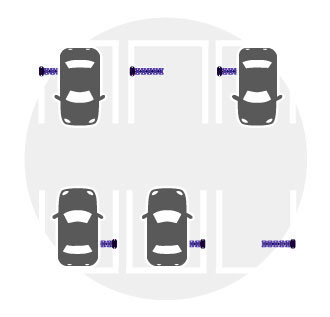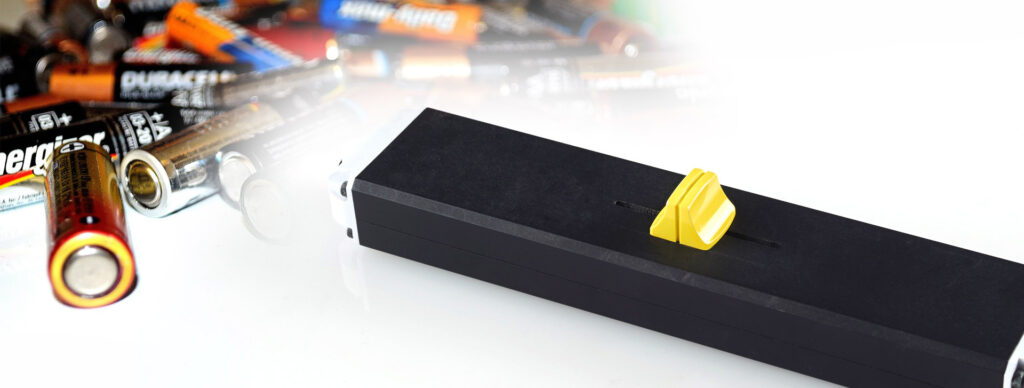Types and benefits of vehicle detection sensors for parking lot management

At Orbray, we often hear concerns regarding parking lot management systems. Comments include, “I want to easily understand the availability of parking spaces, but I'm unsure which management system is ideal,” and “It is difficult to install a new parking lot management system because the initial cost is high.” In this article, we would like to outline some of the advantages and disadvantages of parking lot management systems.
Table of contents [close]
- 1. What are parking lot management systems?
- 2. Types of sensors used in parking lot management systems.
- 3. What is vibration power generation?
- 4. Why is vibration power for parking lot management gaining attention?
- 5. How vehicles are detected with parking lot management systems using vibration power generation
- 6. Examples of vehicle detection sensors for parking lot management in action.
- 7. Summary of parking lot management systems
What are parking lot management systems?

A parking management system is a technological solution designed to make the operation of parking lots and the parking of vehicles more efficient. Orbray’s system offers a range of functions, including monitoring the availability of parking spaces, tracking vehicle movement, and recording parking durations.
In other words, a parking lot management system improves convenience for parking lot operators and parking lot users, and plays a role in reducing congestion and confusion.
Types of sensors used in parking lot management systems.

Many types of vehicle detection sensors are used in parking lot management systems. They are selected based on specific types and requirements of the parking lot. Some commonly used sensors are listed below.
Ultrasonic Sensor System
]Ultrasonic sensors are used to monitor the usage of parking spaces and display their availability. They can also provide directions to drivers within the parking lot.
Vibration Power Sensor System (Self-Powered Vehicle Detection System)
A vibration power generator is installed on the ground and vehicle entry/exit is recorded. The vibrations of a vehicle travelling over the sensor cause signals to be sent.
Loop Coil Sensor System
Electromagnetic induction coils (loop coils) are embedded in the ground to detect the presence of vehicles.
What is vibration power generation?
Orbray's vehicle detection sensors for parking lot management systems use vibration power generation. This technology converts mechanical energy, produced by machines, buildings, human movement, and similar sources, into electric energy.
This technology is gaining significant attention for its contribution to “energy harvesting,” which involves converting natural energy sources into electricity.
Why is vibration power for parking lot management gaining attention?
It addresses parking lot construction and maintenance challenges.
Loop coil systems buried in the ground are typically used as vehicle detection sensors. Using vibration power generators instead can solve the following issues.
- Loop coil sensors require work to bury them under the surface of the parking lot.
- Initial installation cost of the sensors is high.
- The construction period is long.
- Large-scale construction is required for maintenance and removal.
Easy retrofit installation and removal
Orbray's vehicle detection sensors eliminate the need for major construction work, such as digging into the ground. They are installed by simply anchoring the sensors to the ground, and can be operational within approximately 15 minutes after installation. This feature allows for installation, removal, relocation, and maintenance without the need to halt parking lot operations.
External power supply is not needed, due to the vibration power generation technology.
Sensors detect pressure from passing tires and convert it into electric energy, so no external power or batteries are required. By wirelessly transmitting data measured using this electric signal, high-performance and real-time detection is possible.
How vehicles are detected with parking lot management systems using vibration power generation
Orbray's sensors for parking management systems use energy conversion technology to detect vehicles in parking lots. The specific mechanism is as follows.
- Vibration power is generated.
Mechanical vibration energy is generated when vehicle tires pass over vehicle detection sensors installed on the ground or road surface. - Vibration energy is collected.
The vehicle detection sensor contains an electromagnetic induction vibration power generation device. This device collects vibration energy from the source and converts it into electric energy. - Electric signal is generated.
The vibration power generation device generates electric energy from vibrations and powers a sensor that generates data about passing vehicles. - Data is transmitted.
Information regarding the passing vehicle is converted into digital data by the sensor. The data is transmitted to IoT gateways and monitoring devices using wireless transmission. - Vehicle is detected.
The IoT gateway transmits data from multiple devices to a cloud server. This data is used by monitoring applications to determine the availability of parking spaces. These high-performance sensors operate in real time, reliably detecting vehicle passage and providing valuable information for efficient parking lot management.

Examples of vehicle detection sensors for parking lot management in action.
An example of Orbray’s vehicle detection sensor is described here.
Application at a general parking lot
Providing visualizations of the data can help optimize parking lot operations. Specifically, the following benefits can be expected.
Detect parked cars

Detect entry/exit

- Fee revisions
Obtain necessary data to determine optimal parking fees for increased profits. - Review of operating hours
Prevent lost opportunities by investigating potential demand in parking lots that have been closed. - Improvement of operational efficiency and reduction of personnel costs
Determine the optimal placement of parking lot attendants though the obtained data. - Profit forecasts
Conduct demand surveys of new parking lot sites and make profit forecasts before committing to locations.
Application in a logistics center
Vehicle detection sensors can also help solve various logistics issues. Specifically, the following benefits can be expected.
Detect vehicles in berths

Detect vehicles in the waiting area

- Improved accuracy of operation plans
Loading berth operating status and forecasts can be added to operation plans to improve accuracy. - Improved berth utilization rates
Loading and unloading can be optimized by effectively allocating and utilizing existing loading berths - Improved operational efficiency, “white” logistics
Promote white logistics by accurately understanding waiting times for loading and unloading.
Summary of parking lot management systems
Orbray has developed a vehicle detection sensor for parking management systems that is operated by vibration power generation. This system allows effortless gathering of data on occupied and vacant spaces throughout a parking lot, a logistics center, or other venues where the detection of vehicle movement is useful.
By minimizing initial construction costs and utilizing these vibration power generation sensors effectively, a wide range of challenges in both parking management and logistics businesses can be addressed. Our goal is to offer innovative solutions by utilizing the potential of this technology.








